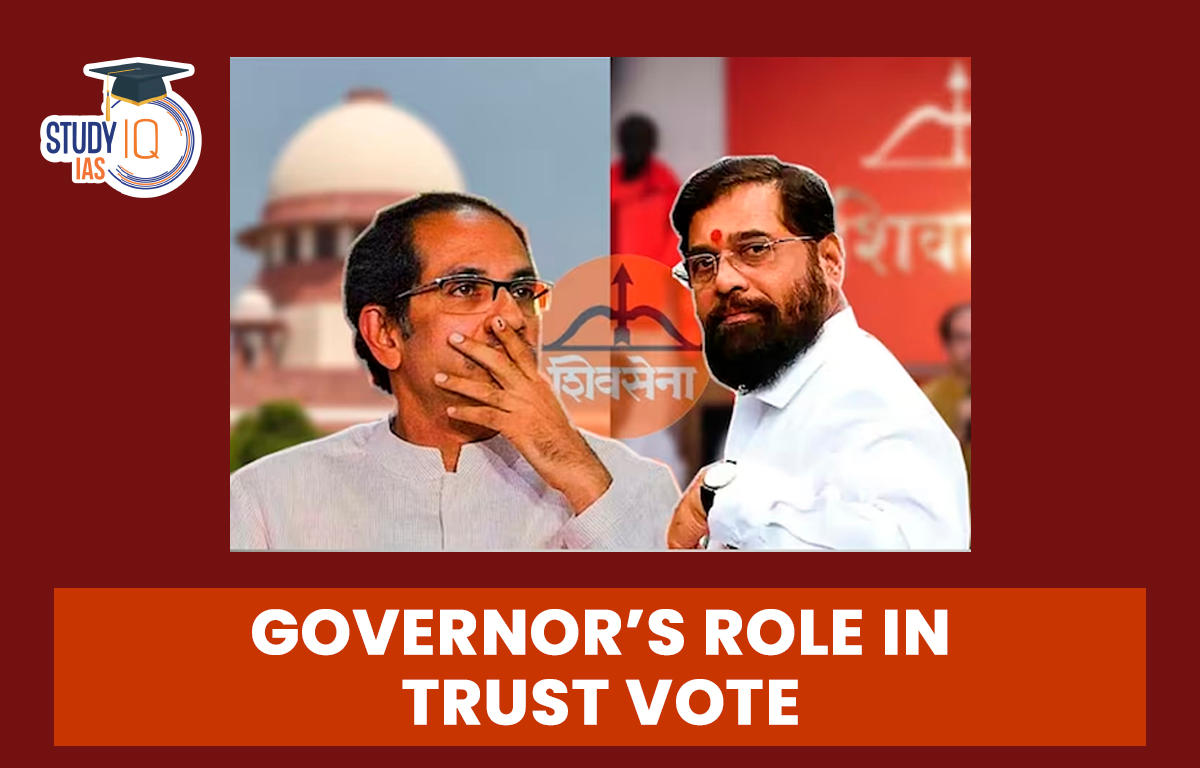Table of Contents
Context: The Supreme Court has observed that the Governor would undermine democracy if they use their constitutional office to call for a trust vote, citing dissension within a ruling political party.
The Supreme Court’s Observations
- The court said that the Governor cannot enter into any area by which his action would result in the fall of a government.
- The court was referring to the decision of Maharashtra Governor to call for a trust vote on the floor of the House, which eventually led to the fall of the MVA government in 2022.
- The court further added that the government had already established its majority in the House, and the Governor using his powers to fasten the fall of an elected government could undermine democracy.
- On the question of violation of core ideology by the ruling party, the court said that it is not a ground for calling of a trust vote by the Governor.
Trust Vote
- A trust vote or floor test or no-confidence motion is a constitutional mechanism used to determine if the ruling government enjoys the support of the legislature.
- This helps the elected representatives to determine if the Council of Ministers enjoyed confidence of the House.
- Objective: The main idea behind the trust vote is to uphold the political accountability of the elected government to the State legislature.
- In Constitution: There is no mention of the term ‘No confidence motion’ or ‘floor test’ in the Constitution, but Articles 75 and 164 mention that the executive is collectively responsible to their respective legislatures.
- A trust vote can only be held in the lower house or the Vidhan Sabha. The gap between two trust votes must be six months.
- Implications of trust vote: The incumbent Chief Minister has to resign if the Council of Ministers fails to prove their majority in the house.
Composite Floor Test
- A Composite Floor Test can be conducted only when more than one person stakes claim to form the government.
- In this case, the governor may call for a special session to see who has the majority.
Process of Trust Vote
- The process finds mention under rule 198 of the Lok Sabha. A no-confidence motion can be moved against the ruling government by any member from the Opposition.
- The motion needs the backing of at least 50 members before it is accepted and subsequently, a date is set by the Speaker for the discussion of the motion.
- The discussion on the motion has to be within 10 days from the date of acceptance.
- Three different types of voting methods can be employed:
- Ballot vote – Voting in secret in a ballot box. It is similar to voting in elections of the Parliament.
- Voice vote – Oral votes of present legislators are taken to determine majority.
- Division vote – Electronic gadgets or slips are used for division of votes.
Governor’s Role in Trust Vote
- Under Article 174 of the Constitution, the Governor can summon, dissolve and prorogue the state legislative assembly. This is carried on the aid and advice of the Council of Ministers.
- However, the Governor can use his discretionary powers under Article 174 only in cases where the Constitution expressly specifies.
- This includes the situation when the chief minister has lost the support of the House and his strength is debatable.
Supreme Court Rulings on Trust Vote/Governor’s role
- Shivraj Chouhan vs Speaker case (2018)
- The Governor can ask for a floor test if he/she believes, based on facts, that the government no longer enjoys the confidence of the legislature.
- The Governor, in any way, shall not favour any party when it comes to the timing of the trust vote.
- Governor can go ahead with a trust vote even if disqualification cases of rebel MLAs is pending before the Speaker of the House, and not wait for the Speaker’s decision.
- The decision of Governor having “relevant and suitable material” to summon a floor test is up for judicial scrutiny.
- SR Bommai Case (1994)
- The court had ruled that the refusal of the Chief Minister to undergo the floor test will be considered as the Government losing the faith of its own legislature.
- Pratap Gowda Patil vs State of Karnataka case (2019)
- The court ruled that the rebel MLAs have the right to skip the floor test voting process in the House.
- The Governor, under provision of Article 174, has the power to dissolve the Assembly at his own discretion, when the state government does not enjoy the confidence of the House.
- Nabam Rebia case (2016)
- The court said that the Governor can summon, prorogue and dissolve the House, only on the aid and advice of the council of ministers.
- However, if the governor had reasons to believe that the chief minister and the council of ministers have lost the confidence of the House, a floor test could be ordered.





















 WhatsApp
WhatsApp